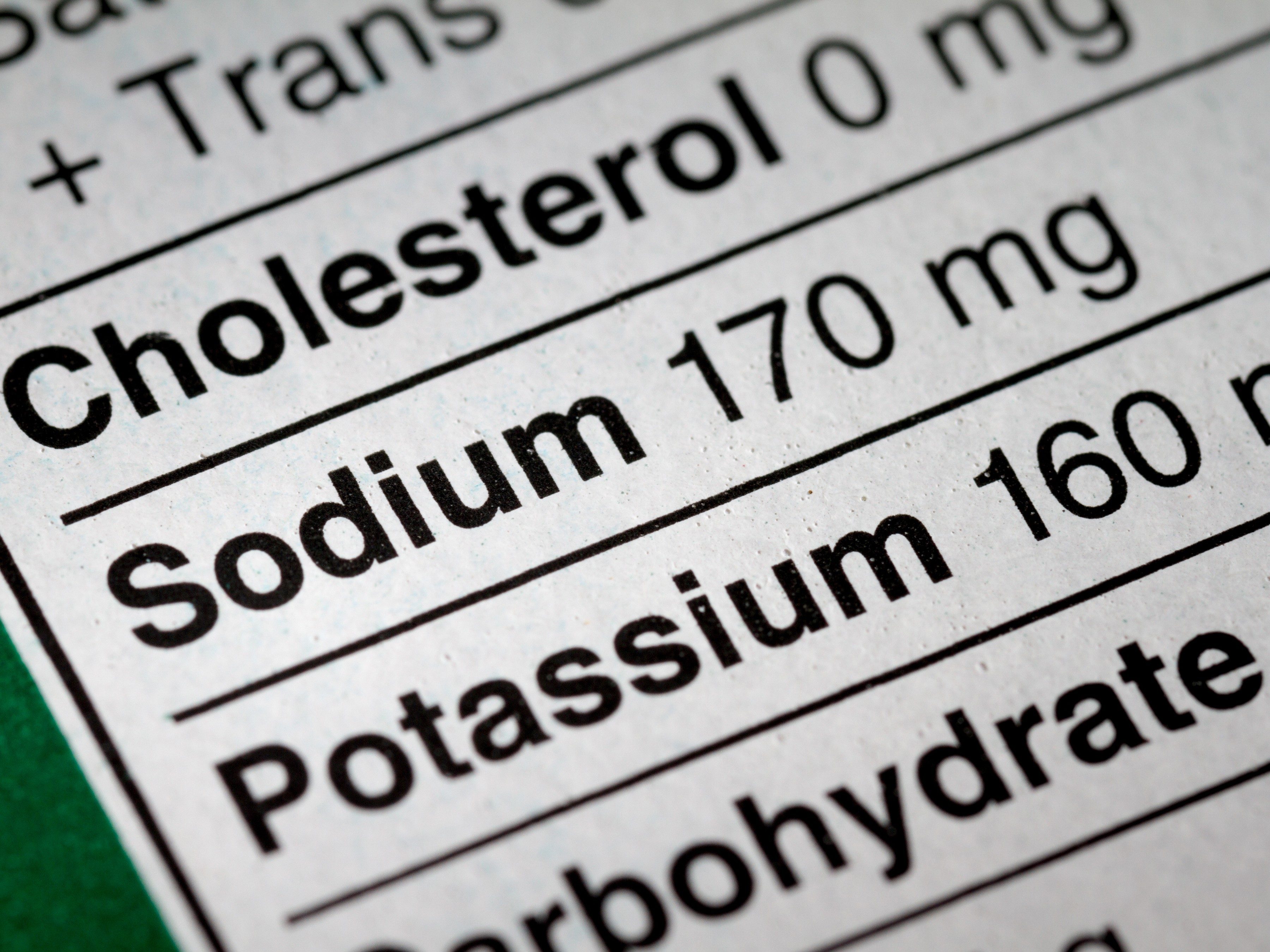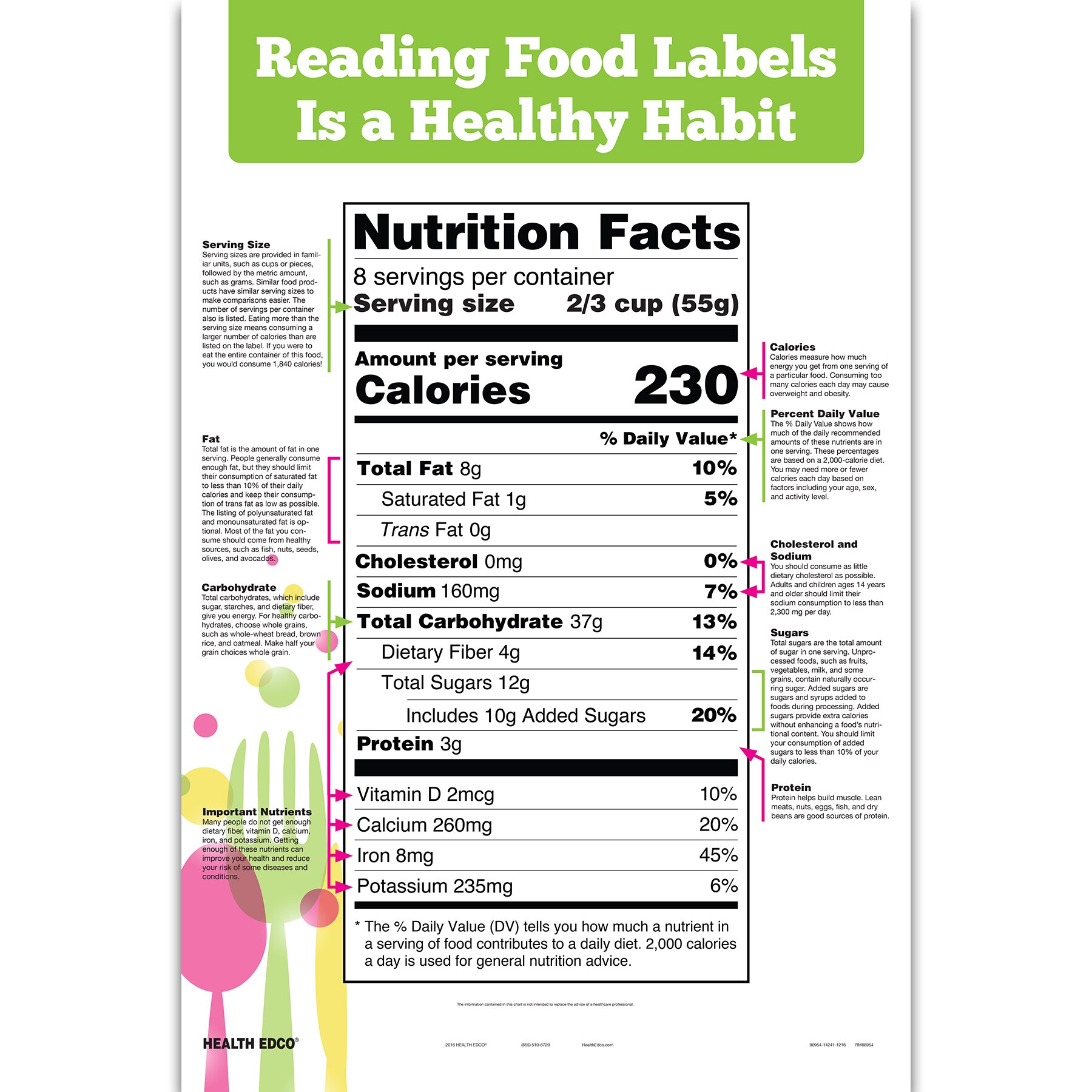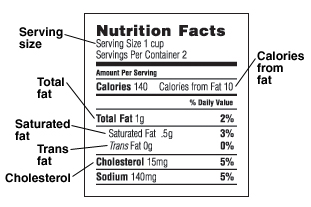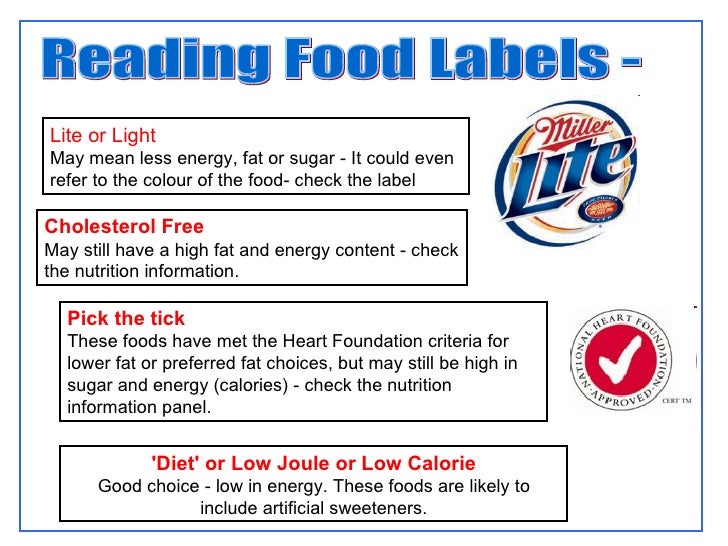42 reading food labels cholesterol
PDF How to Read the Food Label - Risk Services Cholesterol. Cholesterol is in foods from animal sources, such as meats, poultry, fish, eggs, and dairy. Try to keep your cholesterol intake to less than 300 milligrams (mg) per day. A low-cholesterol food has less than 20 mg per serving. Sodium. Too much sodium (salt) may raise your blood pressure. Less than 2,300 mg of sodium each day . is ... How to Read Nutrition Labels: Fat Content, Carbs & What To ... - HighKey Total Fat. Nutrition labels are required to include total fat, saturated fat, and trans fat. The total amount of fat in the diet is a percentage of your calorie needs. The recommendation for the typical American diet is around 30%. For someone taking in 2,000 calories, this would mean around 70 grams of total fat per day.
Reading food labels: Tips if you have diabetes - Mayo Clinic Reading food labels: Tips if you have diabetes. Food labels can be an essential tool for diabetes meal planning. ... Nutrients and Daily Value: The label must list the amounts of total fat, saturated fat, trans fat, cholesterol, sodium, total carbohydrate, dietary fiber, sugars, protein, vitamin D, calcium, iron and potassium that are in one ...

Reading food labels cholesterol
How to read food labels: MedlinePlus Medical Encyclopedia Always check the serving size first. All the information on the label is based on the serving size. Many packages contain more than 1 serving. For example, the serving size for spaghetti is most often 2 ounces (56 grams) uncooked, or 1 cup (0.24 liters) cooked. If you eat 2 cups (0.48 liters) at a meal, you are eating 2 servings. Interactive Nutrition Facts Label The Nutrition Facts label on food and beverage packages shows the amount in milligrams (mg) and the % Daily Value (%DV) of cholesterol per serving of the food. The Daily Value for cholesterol is less than 300 mg per day. Compare and choose foods to get less than 100% DV of cholesterol each day. And remember: Reading Food Labels | ADA - American Diabetes Association The Nutrition Facts labels on foods are really the key to making the best choices. We'll cover the basics so that these labels make shopping easier for you. You've heard it all. From carb-free to low-carb, to whole and empty carbs, it's hard to know what it all means. Blood sugar highs and lows aren't always easy to understand.
Reading food labels cholesterol. PDF How Do I Understand the "Nutrition Facts" Label? "Nutrition Facts" Label? (continued) • Trans Fat - is also considered a "bad fat" because it can raise your LDL cholesterol and your risk of heart disease. Choose foods with "0" grams of trans fat. Read the ingredient list to avoid foods that contain "partially hydrogenated" oils. Everyone can benefit from limiting trans fat. How to Read Food Labels for a Heart-Healthy Diet Agave nectar. Dehydrated cane juice. All of the above. The correct answer is All of the above. Sugar, which provides mostly empty calories that don't boost heart health, can appear several times on an ingredient list because different forms of it have been used in different amounts. But they do add up. How to Read the Nutrition Facts Label on Packaged Foods Sodium. Many people get far too much salt, or sodium. Most of it is in packaged foods and restaurant items. Limit salt to 2,300 milligrams (about 1 teaspoon) daily. If you have high blood pressure ... How to read food labels | UF Health, University of Florida Health If a food has less than 0.5 grams of saturated fat in the serving size on the label, the food maker can say it contains no saturated fat. Remember this if you eat more than 1 serving. You should also pay attention to trans fats on any food label. These fats raise "bad" cholesterol and lower your "good" cholesterol.
A Guide to Reading Food Labels - University of Rochester Feb 27, 2013 · a single serving of this food come from fat. Due to its high fat content, this food is not a healthy choice. Limit These Nutrients . Americans typically eat too much saturated fat, trans fat, cholesterol, and sodium, which can increase the risk for heart disease, cancer or diabetes. Total fat is important to watch, but saturated fat and trans ... Making Sense of Food Labels | ADA Trying to figure out nutritional information on labels and packaging isn’t easy. The good news is that we can help. These food labels are especially helpful if you use carb counting to plan your meals! If you get tripped up on food content claims, you’re not alone. Fat free vs. low fat vs. reduced fat. Low cholesterol vs. reduced cholesterol. How To Read Food Labels Cholesterol - Cholesterol The therapies for high cholesterol entail drugs as well as healthy lifestyle improvements. The healthy way of life renovations contain a well balanced diet, regular physical activity, and also weight control. How To Read Food Labels Cholesterol. Diet plan is the foundation of cholesterol control. There are a number of essential foods to think ... How to read food labels Information | Mount Sinai - New York This number is important for people who are trying to get less salt in their diet. If a label says that a food has 100 mg of sodium, this means it has about 250 mg of salt. You should eat no more than 2,300 mg of sodium per day. This is the amount of sodium that is in 1 measuring teaspoon of table salt.
Understanding Food Nutrition Labels | American Heart Association Remember that the information shown in the label is based on a diet of 2,000 calories a day. You may need less or more than 2,000 calories depending upon your age, gender, activity level, and whether you're trying to lose, gain or maintain your weight. When the Nutrition Facts label says a food contains "0 g" of trans fat, but includes ... Reading Food Nutrition Labels 101 and How to Decode Them Low cholesterol - 20 milligrams or less of cholesterol and 2 grams or less of saturated fat per serving. The manufacturers call it sodium, but everyone knows it is plain old salt. Limit the high sodium foods you eat, aiming for a daily intake of 2400 milligrams or less. Sodium-free - less than 5 milligrams per serving. How to Tell If Foods Are Low or High Cholesterol - Verywell Health Reading Food Labels . Physicians may recommend cholesterol-restricted diets for patients with significantly elevated cholesterol levels and known (or sometimes just high risk of) heart disease. To follow such a diet, it's important to read the nutrition labels on foods before consumin them. How to read food labels - Heart Foundation NZ The star rating is calculated using an algorithm that takes into consideration a number of positive and negative nutrients for a particular food. The positive elements include protein, fibre, fruit, vegetable, nut, seed and legume content. The negative elements include energy, sodium, saturated fat, and sugar.
PDF Interactive Nutrition Facts Label - Cholesterol Interactive Nutrition Facts Label • March 2020 Cholesterol 1 Cholesterol What It Is Cholesterol is a waxy, fat-like substance found in all cells . of the body. Cholesterol is produced by the body (primarily by the liver) and is also consumed from food, referred to as "dietary cholesterol."
Reading Food Labels - Regional Cardiovascular Rehab Facts about reading food labels. Nutrition labels provide information on key nutrients, like fat, carbohydrates, sodium, vitamins, and minerals, and can help you make informed decisions. ... Saturated and trans-fats have been shown to increase cholesterol levels in the blood, which can lead to narrowing and hardening of the arteries. For more ...
Food Labels: Fat & Cholesterol | Home & Garden Information Center The 2015 Dietary Guidelines for Americans recommends the following intakes of fat and cholesterol every day: total fat—20 to 35% of calories, depending on age and gender (65 grams for the 2,000-calorie intake level used in the Daily Value)*. saturated fat—less than 10% of calories**. trans fat— keep as low as possible.
Easy Guide to Understanding Food Labels When You Have High Cholesterol ... 1. Choose products low in saturated fat, trans fat and cholesterol. When shopping for food, use the nutrition information panel to compare and choose products with lower fat, saturated fat and cholesterol content. Saturated fat is a type of fat that raises your total and LDL cholesterol and risk of heart disease, so intake should be limited.

Fascinating Cool Tips: Cholesterol Diet Smoothies cholesterol quotes.Cholesterol Lowering Foods ...
How to Understand and Use the Nutrition Facts Label | FDA It's important to realize that all the nutrient amounts shown on the label, including the number of calories, refer to the size of the serving. Pay attention to the serving size, especially how ...
Understanding Ingredients on Food Labels | American Heart ... These fats raise your bad cholesterol (LDL) and decrease your good cholesterol (HDL). Some experts say you should choose foods with five or fewer ingredients. While this “five-limit rule” has gotten a lot of attention lately, Kris-Etherton said there’s no reason to complicate your label reading to this degree.
Reading Food Labels (for Parents) - Humana - Ohio A food with 5% or less of a nutrient is low in that nutrient. A food with 10%-19% of a nutrient is a good source of that nutrient. A food with 20% or more of a nutrient is high in that nutrient. The information on food labels is based on an average diet of 2,000 calories per day. But the actual number of calories and nutrients that kids need ...
PDF Food Label Tip: Choose Low Saturated Fat Trans Fat and Cholesterol of saturated fat and cholesterol. In general, 5% or less is low. Twenty % or more is high. Also choose foods with no or low amounts of trans fat. Compare these two food labels: Whole Milk Fat-Free Milk. Ft e. These food labels are for one serving of milk: 1 cup (8 ounces). Fat-free milk has the lowest % of saturated fat and cholesterol.
How To Read Food Labels: What's On it & What to Avoid Reading a food label sounds like being back in chemistry class. Does this sound like you? Don't worry, at one point, it was me too. It's time to take the confusion and overwhelm out of reading food labels. ... shelf stable alternative to natural, healthy saturated fats. Unfortunately, trans fats lower good cholesterol (HDL), increase bad ...
How to Read Food Labels : Food Network | Food Network The percent of the Daily Value that is listed on the upper portion of the food label is yet another way to gauge how much saturated fat and cholesterol are in the foods that you buy and eat. If a ...
Reading Food Labels - What You Need to Know - Drugs.com Care guide for Reading Food Labels. Includes: possible causes, signs and symptoms, standard treatment options and means of care and support. ... "Reduced" or "less" fat: At least 25 percent less fat, when compared to a similar food. Cholesterol: "Cholesterol free": Less than two mg of cholesterol per serving. "Low cholesterol": Twenty (20) ...
Food Labels (for Teens) - Nemours KidsHealth Food labels provide more than just nutrition facts. They also tell you what's in a packaged food (i.e., the ingredients). People with food allergies need to check ingredient lists to avoid foods that can cause an allergic reaction. Some food labels also state which country the food came from, whether the food is organic, and certain health claims.
How to read food labels | healthdirect In Australia, the law requires all manufactured foods to carry labels containing safety and nutrition information. This information helps you to make decisions about the food you buy and eat so you can follow a healthy diet. The label will tell you: the name of the product, describing accurately what it is. the brand name.
Reading Food Labels | ADA - American Diabetes Association The Nutrition Facts labels on foods are really the key to making the best choices. We'll cover the basics so that these labels make shopping easier for you. You've heard it all. From carb-free to low-carb, to whole and empty carbs, it's hard to know what it all means. Blood sugar highs and lows aren't always easy to understand.
Interactive Nutrition Facts Label The Nutrition Facts label on food and beverage packages shows the amount in milligrams (mg) and the % Daily Value (%DV) of cholesterol per serving of the food. The Daily Value for cholesterol is less than 300 mg per day. Compare and choose foods to get less than 100% DV of cholesterol each day. And remember:
How to read food labels: MedlinePlus Medical Encyclopedia Always check the serving size first. All the information on the label is based on the serving size. Many packages contain more than 1 serving. For example, the serving size for spaghetti is most often 2 ounces (56 grams) uncooked, or 1 cup (0.24 liters) cooked. If you eat 2 cups (0.48 liters) at a meal, you are eating 2 servings.













Post a Comment for "42 reading food labels cholesterol"